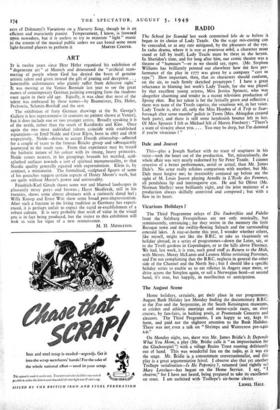ART
IT is twelve years since Herr Hitler organised his exhibition of " degenerate art " at Munich and denounced the "artificial stam- mering of people whom God has denied the boon of genuine artistic talent and given instead the gift of prating and deception ... lamentable unfortunates who plainly suffer from defective sight." It was moving at the Venice Biennale last year to sec the great names of contemporary German painting emerging from the shadows once again in their old age. Equally, it was clear that most of the talent was embraced by these names—by Baumeister, Dix, Hofer, Pechstcin, Schmitt-Rottluff and the rest.
The exhibition of forty German drawings at the St. George's Gallery is less representative (it contains no painter shown at Venice), but it does include one or two younger artists. Broadly speaking it is of the north, rather than the south of Kandinsky and Klee. Once again the two most individual talents coincide with established reputations—in Emil- Nolde and Cesar Klein, born in 1867 and 1876 respectively. Nolde—driven to accept Danish citizenship—adhered for a couple of years to the famous Briicke group and subsequently journeyed to the south seas. From that experience may be traced the barbaric nature of his colour with its strong, heavy primaries. Noldc comes nearest, in his groupings beneath his mottled, acid- splashed surfaces towards a sort of spiritual monumentality, to that Nordic quality generally equated with expressionism. Klein is, by contrast, a miniaturist. The formalised, sculptural figures of some of his gouaches suggest certain aspects of Henry Moore's work, but are quite without Moore's power and universality.
Friedrich-Karl Gitsch shows some wet and blurred landscapes in pleasantly misty greys and browns ; Horst Skodlerak, still in his twenties, shows some almost abstracts with a curiously dated feel ; Willy Knoop and Ernst Witt show some broad post-impressionism. After such a fracture in the living tradition as Germany has experi- enced, it is perhaps unfair to expect the rapid re-establishment of a robust culture. It is very probable that work of value in the visual arts is in fact being produced, but the visitor to this exhibition will look in vain for signs of a new rennaissance.
M. H. MIDDLETON.


































 Previous page
Previous page